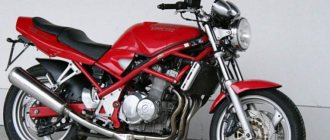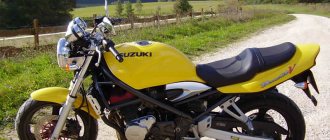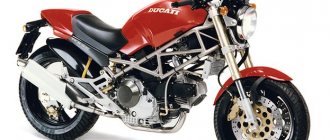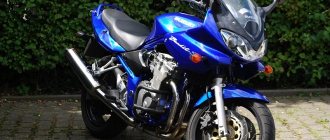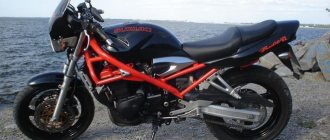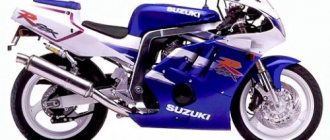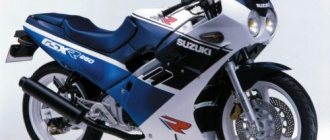First meeting with Suzuki bandit 400
The first meeting with my “Daring” was not impressive. Perhaps it was a passion for choppers and a love for Soviet road motorcycles that had an effect. Perhaps these were echoes of a difficult parting with my beloved Shadik. But the season was in full swing, and there was no choice - an anniversary gift from my brother in the form of a 1996 Suzuki bandit 400 stood in the courtyard of my house, surrounded by knocked down sheathing.
The first sport in my life did not frighten me with “liters” - I arrogantly considered them “nothing” after a liter Honda. “Bandit” knocked down my arrogance in five minutes. I had to relearn how to start, shift and brake. It seemed to me that he was gaining momentum too quickly already in first gear. Turning the gas to full throttle out of habit, I almost flew into the neighbor’s concrete fence. It took two hours to tame the daring technique: he no longer seemed small and pliable.
The second discovery of the motak pleasantly surprised me already on the highway. I went to overtake without dropping the gear, but the acceleration continued at 90 km/h. Despite the rpm being about 7000, the bike accelerated faster and faster. Acceleration dropped just above 110 km/h, reminding me that it was time to switch. Getting used to the temper of “Daring”, I began to understand it and grasp new sensations. Accelerating to a hundred in 5 seconds, although it became familiar to me, gave me a constant rush of adrenaline.
Let it remain unclear who tamed whom during the running-in process, but after a couple of days, “Bandit” became obedient, reliable and dynamic, instantly responding to my actions. We were reconciled by the round headlight, unusual for a modern sports bike, and the absence of unnecessary body kit. Of course, for motorcyclists who have connected their lives with “sports”, the Suzuki Bandit 400 is not the ultimate dream, but it is quite a worthy device for a starting point.
Suzuki gsf 400 bandit: technical specifications
The technical characteristics, which are almost identical for all Suzuki bandit models, have justified themselves 100% in two years. With a volumetric gas tank of 16 liters, gasoline consumption is pleasing: from 5 to 6.5 liters per hundred. Long trips were not burdensome in terms of finances and frequency of refueling. The modest weight of “Daring” is 168 kg. Helps out both on the road and in the garage. The girl will also raise the fallen “bully”. I will provide basic data and characteristics below.
The dimensions of this device are ideal for stability on the road. They provide high dynamics and maneuverability in the city and hard-to-reach places:
- motorcycle length: 2 05.5 cm;
- width: 70.5 cm;
- height: 106.0 cm;
- wheelbase: 43.0 cm.
The engine is in-line, 4-cylinder, 16-valve - quite suitable for the weight of the motorcycle. The power is 59 l/s, the volume is 398 cc/cm. Cooling: liquid radiator.
Most four hundred cars have a limiter of 180 km/h. On my Suzuki Bandit 400, I reached a maximum speed of up to 190 km/h. The steel frame of this bike deserves special attention. The tubular frame and the engine are one piece - it is not hidden behind plastic, it looks reliable and stylish. The pendulum mounting points are reinforced with additional castings.
Article review of the suzuki gsf 400 bandit motorcycle
Suzuki GSF 400 Bandit is one of the classic motorcycles that is ideal for mastering the basics of motorcycling. Now this model will not be able to surprise anyone with its power. But in the 90s it was nonsense (190 km/h!) and the latest technology, in a word - a cult bike. Bandit became especially popular in Japan.
Since 1991, a rather primitive gas distribution system was introduced into the motorcycle, but it was precisely because of this that it never failed and for many it still works. The engine here is an in-line 4-cylinder with liquid cooling, with a power of 53 hp, which in no way distinguishes it from its classmates (Honda CB400 SF, Yamaha XJR400, Kawasaki ZRX 400). The engine from the Suzuki GSX-R400 was taken as the basis, and in 1991 it was redesigned to meet classic performance for smoother traction at medium and high speeds. Before this, the motorcycle had weak traction at low speeds and a sharp pickup after 10,000 rpm. Subsequently, the motor from Bandit was installed on the Suzuki RF400.
Why is this model often called “redhead”? Also in '91, the Bandit gets a variable timing system. We did this in order to improve traction at low speeds, as well as increase engine performance at medium and high speeds. The motorcycle received its sonorous nickname because the cylinder head is painted red.
Now these motorcycles have many disadvantages. They literally live their lives. Something leaks, crackles and rumbles all the time. Therefore, with all the variety of Bandits (GSF250, GSF400, GSF600, Suzuki GSF750, GSF1200, GSF1250), choose any one, the main thing is that it is in good condition.
The advantages of this motorcycle include its endurance. It withstood various falls for decades and worked great, and will withstand another dozen. All because at one time it was done conscientiously. Bandit is unlikely to have a young 400 cc classmate with dual 4-piston front disc brakes or 4 cylinders. Because it is expensive and impractical. In the 90s, this motorcycle was created as the latest technology and they tried to equip it with the best. Perhaps that is why this bike continues to move even after 20 years.
Suzuki GSF 400 Bandit forgives many mistakes for novice motorcyclists. It is simple and unpretentious, but with a sporty spirit, which must be taken into account on the road and if you are not a professional, then you do not need to experiment with gas yet. It easily accelerates to 190 km/h. Engine capacity 400 cm3. (more than enough for a beginner). Classic layout: rear disc brake with 2-piston caliper, diameter - 250 mm; front double disc brake with 2-piston caliper, diameter - 310 mm (very tenacious brakes). One of the minuses is the soft telescopic fork on the front suspension. The seating position is sporty, you have to reach forward with your arms all the time, your legs are located quite high, almost vertically in relation to the body. In general, you can safely buy this motorcycle to prepare for a sportbike. It responds clearly to gas and shifts into gear well. The Bandit also has a smooth, soft engine, excellent grip and a convenient rear-view mirror.
This motorcycle will also appeal to lovers of the classics and everything “real.” After all, there are no electronics here - only a cable that goes to the carburetor and a wonderful sound that is reminiscent of the 90s.
Also, if you manage to find a bike in good condition for the future, you should take into account three “diseases” of this model. Firstly, it is necessary to monitor the timing chain tensioner, which often gets snagged. The second disadvantage is the spark plug wells, which, due to their large size, often contain debris. Thirdly, a drop in compression and wear of the piston rings. This happens on many bikes with variable timing systems, due to the need to turn the engine.
While riding, the driver puts a lot of stress on his hands, so this motorcycle is not for long distances. Its atmosphere is that of a city with its own dense traffic. It behaves well on the road, but for some reason the cutoff occurs at 12 thousand rpm, although the speed should reach 13 thousand. Downshifts don't go as well as upshifts, but if you don't hold your toe too hard on the shift button and let it relax, then everything is fine. The bottom line is this - if you are a beginner, be sure to buy the Suzuki GSF 400 Bandit. With such a bike you can become a good motorcyclist who knows how and what works, and most importantly, how to fix it. Moreover, you can get such joy from 50 thousand rubles.
Suzuki bandit 400: pros and cons
During the two-year period of managing “Daring”, I formed my own view of its advantages and disadvantages. I liked the aggressiveness of “Bandit” - this fully corresponds to its name. Over time, I got used to both the restless throttle and the sharp acceleration. The bike's groovy nature doesn't interfere with the efficient and predictable operation of both disc brakes.
The rear shock absorber is carefully covered from dirt by a fender liner. If necessary, you can adjust the rear suspension to suit your weight, needs and roads. This is done using a system that controls the compression of the springs. And, of course, the engine. It owes its angry streak to the sporting roots of the Suzuki GSX-R400. Its reflection is two fairly short initial gears, and a powerful pickup that begins in standard models around 10,000 rpm.
Suzuki bandit will not do without complaints. The front suspension is too soft for our conditions and requires immediate intervention. You won't be able to drive on average quality tires - this technique only requires good tires. But the saddest thing for people taller than 170 cm is the low frame. Discomfort is caused by the driver's seating position and the position of the legs. All tuning attempts are in vain. All that remains is to adapt to this geometry of the driver’s seat.
The timing chain tensioner often gets stuck - this needs to be checked regularly. Spark plug wells have a large diameter, which is why dust and debris collect there. Before screwing in the spark plugs, it is better to blow out the wells.
Suzuki bandit 400: modifications by year
The Suzuki Bandit motorcycle was produced for a little less than ten years - from 1989 to 1997, without any special design changes. During the time I owned "Daring" (sold a year ago), I was actively interested in its history.
Suzuki GSF 400 Bandit - called grey-headed. This is the first standard version.
Suzuki GSF 400 Bandit V – red head version. With an integrated valve timing expansion mechanism. This system provides sharp acceleration from 8000 rpm. Not only the cylinder head was red, but also the front brake discs. This innovation provoked an increase in the popularity of "Bandit". Based on this model, the Suzuki RF 400, sport/tourer, was released.
According to the official catalog of manufacturers, each modification is assigned individual codes. You can find this information on a sticker under the saddle. It contains the following data: Suzuki GSF 400 **. The asterisks indicate the year code and model. Just below there is an inscription by which you can check the original color.
1989 – start of production and sales of Suzuki Bandit 400
The model is assigned code K. Characteristic features: gray color of the cylinders. The coloring of the first "Bandits": black with a blue streak and red.
1990 – Limited version released
The code for this release is L. The luxury variation of the pioneer received a semi-fairing and a stiffer “unkillable” suspension. Production of the standard black version also continued.
1991 – production of stock models continues, and modification V appears
In the first half of the year, production of standard “grayheads” is underway. The year code for this model is M. Under the code is MV, in the second half the “red-headed” V version was released. This characteristic feature increased the demand for new bikes. “Standard” colors: red, black and red with a silver frame.
Version two, luxury. Limited V pleases with a double color: silver-blue and silver-red, and the main indicators have not changed.
The year 1991 was marked by the opening of supplies of “Hooligan” to Europe. For each country, different versions of the Suzuki bandit 400 were produced. It is reliably known that there were cosmetic solutions for the color of the exhaust system, fork and brake discs. Models for Germany were equipped with a 50 hp engine and round mirrors were installed on them. For England, the power unit remained the same, but the front brake was single disc.
1993 – power reduction and speed limit by manufacturer
Changing Japanese laws led to the “strangulation” of 400 cc equipment to 53 hp. and a speed limit of up to 180 km/h. As a consolation, a small trunk was added under the seat. Since the spring of 1994, all modifications have been produced with an electronic limiter.
1995 – appearance of the second generation
The appearance of the “red head” restyling in 1995 under the code S marked the second life of the 400. The updated design, lightweight chassis, aluminum swingarm and shortened wheelbase bring a modern spirit to this version. Characteristic features: dual seat, red and yellow front hub and silver fork. Of course, the red head on the cylinder block remained unchanged.
1997 – end of production
The next tuning of the “red-headed” Suzuki bandit 400 left the technical characteristics in the previous version. The only thing that marked it significantly was the appearance of modern aggressive fairings. Variations of the muffler and color scheme appeared. The code of the last "Bandit" of 1997 is V.
Over the years, Japanese designers have changed the shape of attachments and perfected the engine and chassis. We experimented with materials from chromium to aluminum. We don’t know what prevented manufacturers from using such promising potential for further restyling in full. But, despite the fact that restrictions “strangled” at least 15% of the possibilities, the daring character of the motorcycle has been preserved and continues to delight owners.
Suzuki Bandit 400 – the king of the era
The “four hundredth” Bandit is perhaps the most successful version of the flagship road motorcycle. This is where the success of this model began
Sergey Yakovlev
The GSF-250 and GSF-400, which appeared in 1989, hit a big jackpot both in the Japanese and in the world market. The history of the Suzuki Bandit 400 includes as many as sixteen modifications - the bike was produced for eleven years, until 2000.
On Russian roads you could most often find the 1991 version, but the most serious transformation took place in 1995: the engine and chassis were modernized, and the frame was redesigned. The power unit, according to domestic Japanese standards, was derated to 53 horsepower, but did not seem less powerful, since Suzuki significantly modernized the valve timing system. The shape and volume of the fuel tank has changed. The design of the motorcycle as a whole has become more sporty and modern. In particular, the location of the driver's seat was revised, but the Japanese were unable to solve the problem of the “shortness” of the bike: a person taller than 180 centimeters feels uncomfortable, does not fit on the motorcycle, and his knees are at the same level as the fuel tank. This can be explained by the fact that initially the model was designed exclusively for the Japanese market, and among the Japanese, as we know, there are few giants.
Suzuki Bandit 400
The Suzuki Bandit 400 engine came from the GSX-R400 sportbike. This is a four-cylinder water-cooled engine with a volume of 400 cubic centimeters and a power of 59 horsepower in its latest modification in 1999. Its combination with a six-speed gearbox provides interesting dynamics of the model. The gearbox, however, is significantly inferior to Honda's. The Bandit's on-road performance lives up to its name. The first two gears have to be changed very quickly, but at high speeds and at 10,000 rpm the motorcycle demonstrates quite a strong character. Acceleration to hundreds takes between five and six seconds, and the top speed of the iconic road bike is 180 kilometers per hour. Fuel consumption is slightly higher than expected from a 400cc motorcycle, with the Suzuki Bandit consuming up to 7 liters per 100 km. The owners of this model highly praise the brakes: they were borrowed from the same sports GSX-R400.
Suzuki Bandit 400
A serious advantage of the “four hundredth” Bandit was its price. There were hardly any similar offers in the lower price category. Today, the Suzuki Bandit 400 remains very popular in Russia, despite the fact that it has long been discontinued: on the secondary motorcycle market its price ranges from 50 to 150 thousand rubles.
The editors recommend:
How to reduce washer fluid consumption?
Russians will be able to catch traffic violators on their phones
Where is it better to store a car - in a garage or outside? Opinions for and against
Advanced truck driver and savings on service: what do cargo carriers rely on?
New law: fine drivers for speeding 5 km/h
Discussion Cancel
I want to receive the most interesting articles
Suzuki bandit 400 owner reviews
I had a Suzuki Bandit 400 redhead 59 l/s. I bought it from Japan in 2007. Went for three seasons. Mot is fire. During this time I replaced the charging relay. Victor, Saratov.
From motak there are only positive emotions! The “bandit” was imprinted in my memory with his passion. The name fully justifies it. Mine also had a small tuning – lowered clip-ons. The landing turned out to be in the shape of a shrimp! But it was still clear to me. Excellent equipment that has never broken. Alexey, Moscow.
I only changed the pads in a couple of seasons. No problem. Nikolay, Novosibirsk.
I had a red head. God forbid! This is the most suitable device for the city. Some positive characteristics. The charging relay broke, but the Chinese one from the moped worked. Sergey, Vladivostok.
For the Suzuki bandit 400, reviews on the Internet and in personal communication, for the most part, I have encountered only positive ones. After two years, I often remember my “Daring” with only good words.
Review of the Suzuki GSF 400 Bandit motorcycle
I bought a GSF 400 for 90 rubles as my first motorcycle. Along with the motor, we also got problems with carbs, which are typical for this year. We managed to cure them only this season by completely replacing them with carbs from RF400. After a fall last season, the bike periodically acted up and started very poorly, for a long time I could not understand why, but in the end I found out the dependence of the hall sensor on humidity and air temperature. Cured by replacing the hall sensor. The fork turned out to be surprisingly strong, I flew into holes many times, even rolled the disc, the fork doesn’t care, it doesn’t leak, the only negative is a little soft. The rear suspension is quite soft, but when you drive with number 2, it often rubs the fender liner on strong bumps. In general, I’m happy with the suspensions, they are quite soft, but even when cornering at a speed of 130-140 when you’re almost drawing the footpegs, they don’t float much.
I bought him when he was quite tired and he died. He lived and died. Here I learned all its negative sides, namely: the manuals are thin (if anyone thinks otherwise, check out the manual for the YZF R1 2002), there are a lot of spare parts, but there were also more. For the same CB 400 it is much easier to find Mikuni carburetors...... It's just terrible! It seems like everything is as usual, but the abundance of rubber bands and the fastening of the float in the chamber simply blows my mind. Of course, you can buy a set of original rings, rubber bands and needle valves, but you will have to save money in your backpack; in general, the reliability of the power unit is noticeably lower than that of the CB 400: the sibiha is more widespread, and it is more difficult to find one with a dead engine or gearbox.
for those who dream of a sportbike - the best first motorcycle. Throttle response, sharp, nimble, but teaches you to choose the right speed! On bad asphalt it becomes difficult to control, and on rails the steering wheel wobbles! But even just two people can beat many 400s on it!
The LIMITED version was made for the 70th anniversary of Suzuki, it differed from the usual one in the presence of a semi-fairing and an adjustable front suspension, I did not notice any other differences. An excellent motorcycle, with a unified, very angry sports engine from the GSXR400, which provokes it to spur it on. Specifically, on my motorcycle, higher-capacity main fuel jets and a real aluminum direct-flow muffler were installed (here is the sound https://www.youtube.com/watch?v=cA6zv4BEUVI&feature=related) I can only assume that he was driving a little faster than usual. The engine is an in-line four 16 valves 59 hp/12500 has a variable valve timing system Variable Control (https://www.youtube.com/watch?v=7IIlplh-Yt4) an analogue of the Honda VTEC turns on after 8000 rpm (the valves open more ) in the first three gears it feels like a strong kick in the backside, to be honest this thing is very tasty, in general the motorcycle is not boring. It goes with a bang, easily reaches its required 185 and then accelerates, a comfortable driving speed of 100-120. The motorcycle is very, very easy to handle, just like a bicycle, but the low-mounted muffler resonator and the footrest prevent it from turning sharply, I managed to draw this thing several times.
The disadvantages are that the suspension settings are too soft, even pressing the rear spring all the way does not change the situation in any way; the front stay plugs have spring preload adjustments (specifically on my LTD model), but they do not change the situation specifically. The motorcycle does not like bad roads. I inserted a filter into the fuel line - very capricious carburetors, they start poorly when it gets cold and if it sits for a long time, it doesn’t tolerate blockages at all (at first my first cylinder didn’t work, I didn’t understand why, I disassembled the carbs, took out a bunch of dirt from the jets and installed it and the problem disappeared)
The motorcycle is very easy to repair; all consumables can be changed by yourself without any problems. Personally, I myself changed the gears in the garage: sprockets, chain, filters, spark plugs, replacing brake fluid and bleeding the brakes, engine oil, completely overhauling the feathers - replacing anther seals and fork oil, cleaning and synchronizing carburetors is an elementary matter. The head light with a standard lamp is just a candle, installing bi-xenon changed things radically. Overall: a reliable, unpretentious, lightweight, maneuverable motorcycle. I think that not only beginners will like it. For people with long legs and/or a height of about 190 (my case), the fit will seem a little low and as a result, uncomfortable at first, then you get used to it and it’s normal.
Separately about the brakes: of course, there are never too many brakes - two huge perforated discs with four-piston calipers at the front are too tenacious brakes.
I think this bug is the best in its class.
I haven’t ridden a motorcycle far for a long time, but when I hit the highway 150 km away, it became scary. You can feel the power of the engine, and the motorcycle itself feels like it’s alive, you almost feel like a bandit. The seat is very comfortable, both for the driver and probably for the passenger. I didn’t bother anyone in particular, I put the girls in jail a couple of times, when we left the city, we almost shit ourselves out of fear. However, if you are tall, it will be a little uncomfortable to sit - the design of the frame is such that your knees will be level with the gas tank.
The brakes are very good, especially the front one. The motorcycle itself is very maneuverable, but when turning, you need to get used to the controls, otherwise you can fly far off the road at high speed, and here they are in the mountains and the slopes are often steep. It is especially dangerous to drive in the rain. It would be better, I would say, not to ride at all, especially when it’s just starting to rain, and even less so when you haven’t mastered the basic skills on this motorcycle.
Thus, this is just a beast of a motorcycle, I still regret that I didn’t buy it at the time.
A few words for future owners and novice drivers
Concluding the description of the Suzuki bandit, I would like to once again emphasize its advantages in combination with the affordable cost on the secondary market. The price for them starts from 50,000.00 rubles. Unused models cost, on average, between $2,000 and $3,000. These qualities attract not only experienced bikers, but also beginners.
It should not be used as a first motorcycle if you do not have sufficient driving experience. The Bandit's grip is so strong and unexpected that you can easily lose control over it. This is especially true when it comes to cornering. Short, low gears also cause discomfort when moving around the city - this is determined by the technical characteristics of the transmission in the Suzuki Bandit 400. For those who crave adrenaline from the first season, it is better to choose the Yamaha YBR 125 motorcycle, a review of which you can find on the website. Yamaha has successfully trained tens of thousands of novice drivers, and holds the lead among “training” equipment.
The Suzuki Bandit 400 is ideal for more experienced motorcyclists who have a confident feel for the road and speed. Japanese designers have pretty much “strangled” the motorcycle, opening up a gigantic potential for customization, boosting and tuning. For those whose hands are growing out of the right place, this Japanese badass “Hooligan” will be the best choice. It makes it much easier to understand what you want from a motorcycle.
Specifications
| Maximum engine power: | 59 HP |
| Torque: | 38 Nm |
| Working volume: | 398 cm3 |
| Motor type (cylinder arrangement, number of strokes): | In-line, 4 cylinders, 16 valves. |
| Number of cylinders: | 4 |
| Number of valves: | |
| Intake type (Injector / Carburetor): | |
| Bore and stroke: | |
| Starting system (Electric starter, kick starter): | |
| Maximum speed in km/h: | 180 km/h |
| Cooling system: | liquid |
| Transmission (gearbox): | 6 |
| Clutch (Dry / Wet): | |
| Drive unit: | Chain |
| Frame: | steel tubular |
| Chassis | |
| Suspension (front/rear travel): | |
| Brakes (Front/Rear): | |
| Wheels / Tires / Rubber: | |
| Dimensions and weight | |
| Dimensions (Length / Width): | |
| Seat height: | |
| Ground clearance: | |
| Curb weight: | |
| Wheelbase: | 1430 mm |
| Weight: | 168 kg |
| Fuel tank capacity: | 16 l. |
| Battery capacity: | |
| Year of release: | |
| Country of Origin: |
